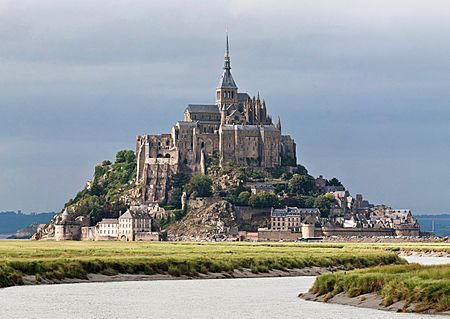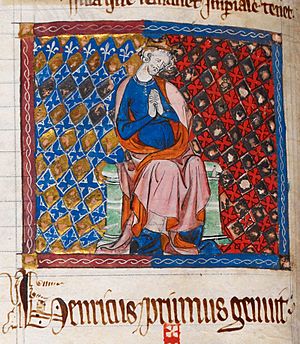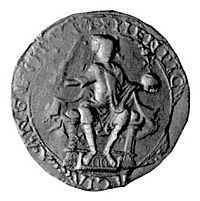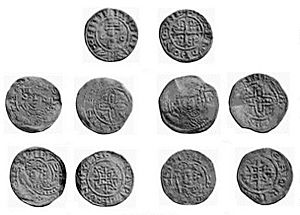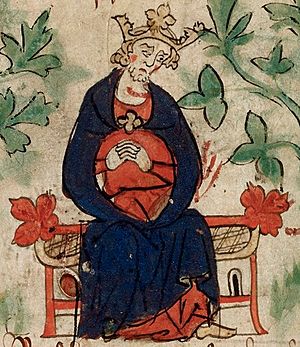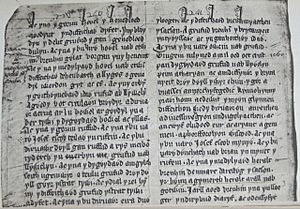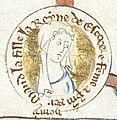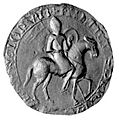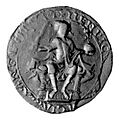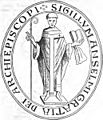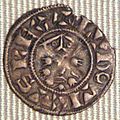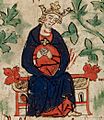Henry I of England facts for kids
Quick facts for kids Henry I |
|
|---|---|

Miniature from Matthew Paris's Historia Anglorum, c. 1253. The portrait is generic and depicts Henry holding the Church of Reading Abbey, where he was buried.
|
|
| King of England (more ...) | |
| Reign | 5 August 1100 – 1 December 1135 |
| Coronation | 5 August 1100 |
| Predecessor | William II |
| Successor | Stephen |
| Duke of Normandy | |
| Reign | 1106 – 1 December 1135 |
| Predecessor | Robert Curthose |
| Successor | Stephen |
| Born | c. 1068 Possibly Selby, Yorkshire, England |
| Died | 1 December 1135 (aged 66–67) Saint-Denis-en-Lyons, Normandy, Kingdom of France |
| Burial | Reading Abbey |
| Spouse | |
| Issue more ... |
|
| House | Normandy |
| Father | William the Conqueror |
| Mother | Matilda of Flanders |
Henry I (born around 1068 – died 1 December 1135), also known as Henry Beauclerc, was the King of England from 1100 until his death in 1135. He was the fourth son of William the Conqueror, who had invaded England in 1066. Henry was educated in Latin and the liberal arts.
When his father William died in 1087, Henry's older brothers, Robert Curthose and William Rufus, inherited Normandy and England. Henry, however, was left without land. He bought the County of Cotentin in western Normandy from Robert. But his brothers took it back from him in 1091. Henry slowly built up his power again in the Cotentin. He then became friends with William Rufus against Robert.
In 1100, Henry was present when his brother William Rufus died in a hunting accident. Henry quickly took the English throne. He promised to change many of William's unpopular rules. He married Matilda of Scotland, and they had two children who lived: Empress Matilda and William Adelin. Henry also had many other children with different women.
Robert, who invaded from Normandy in 1101, challenged Henry's rule in England. This fight ended with a peace deal that confirmed Henry as king. But the peace did not last long. Henry invaded Normandy in 1105 and 1106. He finally defeated Robert at the Battle of Tinchebray. Henry kept Robert in prison for the rest of his life.
Henry's control of Normandy was challenged by Louis VI of France, Baldwin VII of Flanders, and Fulk V of Anjou. They supported Robert's son, William Clito, who also claimed the Duchy. A big rebellion happened in Normandy between 1116 and 1119. After Henry won the Battle of Brémule, a good peace deal was made with Louis in 1120.
People at the time thought Henry was a strict but good ruler. He was skilled at managing the powerful nobles in England and Normandy. In England, he used the existing Anglo-Saxon system of justice and taxes. He also made it stronger with new groups like the royal exchequer (treasury) and traveling judges. Normandy was also ruled with a growing system of judges and a treasury. Many of Henry's officials were "new men" from less important families. They became important administrators.
Henry encouraged Church reforms. But he had a serious disagreement with Archbishop Anselm of Canterbury in 1101. This was solved with a compromise in 1105. He supported the Cluniac religious order. He also played a big role in choosing important Church leaders in England and Normandy.
In 1120, Henry's son William drowned in the White Ship disaster. This made the future of the throne unclear. Henry married a second wife, Adeliza of Louvain, hoping for another son. But they had no children. Because of this, he declared his daughter Matilda his heir. He also married her to Geoffrey of Anjou. The relationship between Henry and the couple became difficult. Fighting started along the border with Anjou.
Henry died on 1 December 1135 after being sick for a week. Even though he planned for Matilda to be queen, his nephew Stephen of Blois became king. This led to a civil war called the Anarchy.
Henry's Early Life (1068–1099)
Childhood and Education
Henry was likely born in England in 1068. It might have been in the town of Selby in Yorkshire. His father was William the Conqueror. William was the Duke of Normandy who invaded England in 1066. He became the king of England. His lands stretched into Wales.
The invasion created a ruling class of Anglo-Normans. Many of them owned land on both sides of the English Channel. These nobles often had strong ties to the Kingdom of France. France was then a loose group of smaller areas. Henry's mother, Matilda of Flanders, was the granddaughter of Robert II of France. She probably named Henry after her uncle, King Henry I of France.
Henry was the youngest of William and Matilda's four sons. He looked like his older brothers. He was "short, stocky and barrel-chested," with black hair. He probably did not see much of his older brothers because of their age difference. His brother Richard died young. He likely knew his sister Adela well, as they were close in age.
We do not have many records about his early years. Historians think he grew up mostly in England. He was probably taught by the Church. It is not clear if his parents wanted him to become a priest. He could probably read Latin and knew some liberal arts. He also had military training. His father made him a knight on 24 May 1086.
How Henry Inherited His Lands
In 1087, William the Conqueror was badly hurt during a war. Henry was with his dying father near Rouen in September. The King divided his lands among his sons. Rules for who inherited land were not clear back then. In some parts of France, the oldest son got everything. But in Normandy and England, lands were often divided. The oldest son got the most important lands. Younger sons got smaller or newly won areas.
William seemed to follow the Norman way. He separated Normandy, which he inherited, from England, which he won in war. William's second son, Richard, had died. This left Henry and his two brothers to inherit. Robert, the oldest, got Normandy. This was even though he was fighting his father at the time. England went to William Rufus, who was favored by the dying king. Henry received a large sum of money, about £5,000. He was also supposed to get his mother's lands in Buckinghamshire and Gloucestershire.
Robert went back to Normandy. He expected to get both Normandy and England. But William Rufus had already gone to England and been crowned king. The brothers disagreed about the inheritance. Robert soon planned to invade England to take the kingdom. Some important nobles helped him rebel against William Rufus. Henry stayed in Normandy. He worked with Robert's court. He might not have wanted to openly side with William Rufus. Or Robert might have taken Henry's money if he tried to leave. William Rufus took Henry's new lands in England, leaving Henry without land.
In 1088, Robert's invasion plans failed. He asked Henry to lend him some of his money, but Henry refused. Then, Henry and Robert made a different deal. Robert would make Henry the count of western Normandy for £3,000. Henry's lands were a new countship. It gave him power over the Cotentin and Avranchin areas. This also gave Henry influence over important Norman leaders. Robert's invasion force never left Normandy. This left William Rufus safe in England.
Henry as Count of Cotentin
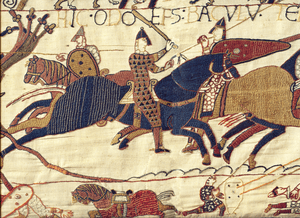
Henry quickly became a strong count. He gathered many followers from western Normandy and eastern Brittany. These early supporters included important nobles and a churchman. Robert tried to break his deal with Henry and take back the county. But Henry was already too strong to stop him. Robert's rule of Normandy was messy. Parts of Henry's lands became almost independent from Rouen.
During this time, neither William nor Robert seemed to trust Henry. Henry returned to England in July 1088. He waited until the rebellion against William Rufus was over. He met with the King but could not get his mother's lands. He went back to Normandy in the autumn. While he was away, Odo, Bishop of Bayeux, had convinced Robert that Henry was plotting against him with William Rufus. When Henry landed, Odo captured him. He imprisoned Henry in Neuilly-la-Forêt. Robert took back the county of Cotentin. Henry was held there over the winter. But in the spring of 1089, important Norman nobles convinced Robert to release him.
Even though he was not officially Count of Cotentin anymore, Henry still controlled western Normandy. The fight between his brothers continued. William Rufus kept putting down rebellions in England. But he also started making alliances against Robert in Normandy. Robert allied with Philip I of France. In late 1090, William Rufus encouraged Conan Pilatus to rebel against Robert in Rouen. Conan was supported by most of Rouen.
Robert asked his nobles for help. Henry was the first to arrive in Rouen in November. Violence broke out, leading to fierce street fighting. Both sides tried to take control of the city. Robert and Henry joined the battle. But Robert then left, leaving Henry to continue fighting. The battle turned in favor of the Duke's forces. Henry captured Conan. Henry was angry that Conan had turned against his lord. He took Conan to the top of Rouen Castle. Despite Conan offering a huge ransom, Henry threw him off the castle to his death. People at the time thought Henry acted correctly. Henry became famous for his actions in the battle.
Henry's Rise to Power
After the battle, Robert made Henry leave Rouen. This was probably because Henry had played a bigger role in the fight than Robert. Also, Henry might have asked to be made Count of Cotentin again. In early 1091, William Rufus invaded Normandy with a large army. This made Robert agree to talk. The two brothers signed a treaty in Rouen. William Rufus gained lands and castles in Normandy. In return, William Rufus promised to help Robert take back Maine. They also agreed to help each other control Normandy, including Henry's lands. They named each other as heirs to England and Normandy. This meant Henry would not inherit as long as either of them lived.
War then broke out between Henry and his brothers. Henry gathered an army of hired soldiers in western Normandy. But as William Rufus and Robert's armies came closer, Henry's supporters left him. Henry gathered his remaining forces at Mont Saint-Michel. He was besieged there, probably in March 1091. The place was easy to defend but had no fresh water. One writer said that when Henry ran out of water, Robert allowed him fresh supplies. The details of the end of the siege are unclear. Henry left Mont Saint-Michel, probably after agreeing to surrender. He went to Brittany and then to France.
Henry's next actions are not well known. One writer says he traveled in France for over a year with a small group. By the end of the year, Robert and William Rufus had fallen out again. Their treaty was broken. In 1092, Henry and his followers took the Norman town of Domfront. The people of Domfront did not like their previous ruler. They invited Henry to take over, which he did without a fight. Over the next two years, Henry rebuilt his network of supporters in western Normandy. By 1094, he was giving lands and castles to his followers. He acted as if he were the Duke of Normandy. William Rufus started giving Henry money. He encouraged Henry's fight against Robert. Henry used some of this money to build a strong castle at Domfront.
William Rufus went to Normandy in 1094 to fight Robert. When things slowed down, he asked Henry for help. Henry responded, but went to London instead of joining the main fight. This might have been at the King's request. William Rufus then stopped his campaign and went back to England. Over the next few years, Henry seemed to get stronger in western Normandy. He visited England sometimes to attend William Rufus's court. In 1095, Pope Urban II called for the First Crusade. Robert joined the Crusade. He borrowed money from William Rufus to do so. In exchange, he gave the King temporary control of his part of Normandy. The King seemed sure he would get the rest of Normandy from Robert. Henry became very close to William Rufus. They fought together in Normandy between 1097 and 1098.
Becoming King (1100–1106)
Taking the Throne in 1100
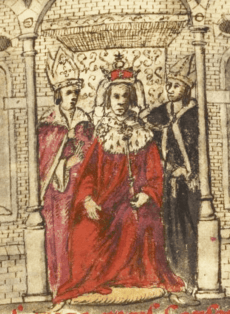
On the afternoon of 2 August 1100, King William Rufus went hunting in the New Forest. Henry was with him, along with other nobles. An arrow, possibly shot by Walter Tirel, hit and killed William Rufus. Many people have thought the King was killed on purpose. But most historians today do not agree. Hunting was dangerous, and accidents were common. Chaos broke out. Tirel fled to France. He might have shot the arrow, or he might have been wrongly blamed and feared punishment.
Henry rode to Winchester. An argument started about who should be king. William of Breteuil supported Robert, who was still away on the Crusade. Henry argued that he was born to a reigning king and queen. This gave him a stronger claim. Tempers rose, but Henry, with support from powerful nobles, won. He convinced the nobles to follow him. He took Winchester Castle and the royal treasury.
Henry was quickly crowned king in Westminster Abbey on 5 August. Maurice, the bishop of London, performed the ceremony. Anselm, the archbishop of Canterbury, was in exile. Thomas, the archbishop of York, was in the north. To make his rule seem right, Henry issued a coronation charter. It made various promises. The new king said he would bring order back to the country. He promised to stop William Rufus's harsh policies towards the Church. He also promised to protect the nobles' property rights. He said he would return to the gentler customs of Edward the Confessor. He declared he would "establish a firm peace" across England.
Henry rewarded his existing supporters with new lands. He also kept many officials from the old government. William Giffard, William Rufus's chancellor, became the bishop of Winchester. Other important officials stayed in their roles. But the unpopular Ranulf Flambard, a key member of the old government, was imprisoned. He was charged with corruption. The late king had left many Church positions empty. Henry started appointing new people to these roles. This helped him gain more support. He wrote to Anselm, apologizing for being crowned without him. He asked Anselm to return at once.
Henry's Marriage to Matilda
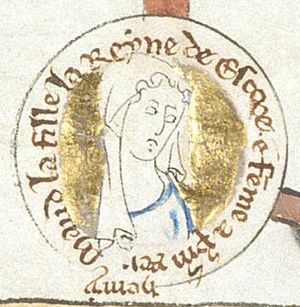
On 11 November 1100, Henry married Matilda. She was the daughter of Malcolm III of Scotland. They married in Westminster Abbey. Henry was about 31 years old. Late marriages for noblemen were not unusual then. They had probably met earlier. Historians believe Henry and Matilda were close. But their marriage was also for political reasons. Matilda's first name was Edith, an Anglo-Saxon name. She was from the West Saxon royal family. She was related to Alfred the Great. Marrying Matilda gave Henry's rule more legitimacy. For Matilda, it was a chance for high status and power.
Matilda had been educated in convents. She might have taken vows to become a nun. This was a problem for the marriage. She did not want to be a nun. She asked Anselm for permission to marry Henry. The Archbishop held a meeting to decide the issue. The meeting decided that Matilda had lived in a convent but was not a nun. So, she was free to marry. Anselm agreed, and the marriage went ahead.
Matilda was a good queen for Henry. She sometimes ruled England when he was away. She attended and led meetings. She also strongly supported the arts. The couple soon had two children: Matilda, born in 1102, and William Adelin, born in 1103. They might have had another son, Richard, who died young. After their children were born, Matilda preferred to stay in Westminster. Henry traveled across England and Normandy.
The Treaty of Alton (1101–1102)
By early 1101, Henry's new government was working. But many Anglo-Norman nobles still supported his brother Robert. Or they were ready to switch sides if Robert seemed likely to win. In February, Flambard escaped from the Tower of London. He went to Normandy. There, he helped Robert plan an invasion. By July, Robert had an army and a fleet ready to attack Henry in England. Henry took Flambard's lands. With Anselm's support, Flambard was removed as bishop. The King held meetings in April and June. Nobles renewed their promises of loyalty. But their support still seemed weak.
With the invasion coming, Henry gathered his forces and fleet. They were near Pevensey, where Robert was expected to land. Henry personally trained some of his troops. Many English soldiers and knights arrived. But many of his nobles did not show up. Anselm talked to those who doubted. He stressed the religious importance of being loyal to Henry. Robert unexpectedly landed at Portsmouth on 20 July. He had only a few hundred men. But many English nobles quickly joined him. Instead of marching to Winchester to take Henry's treasury, Robert paused. This gave Henry time to march west and stop the invasion.
The two armies met at Alton, Hampshire. Peace talks began. The brothers agreed to the Treaty of Alton. Robert released Henry from his promise of loyalty. He recognized Henry as king. Henry gave up his claims to western Normandy, except for Domfront. He agreed to pay Robert £2,000 a year for life. If either brother died without a son, the other would inherit his lands. Nobles who had lost lands for supporting a rival would get them back. Flambard would be made bishop again. The brothers would fight together to defend their lands in Normandy. Robert stayed in England for a few months. Then he returned to Normandy.
Despite the treaty, Henry punished nobles who had fought against him. William de Warenne was accused of new crimes. He was banished from England. In 1102, Henry turned against Robert of Bellême and his brothers. They were very powerful nobles. Henry accused Robert of 45 different crimes. Robert escaped and fought against Henry. Henry attacked Robert's castles. Robert's power in England was broken. He accepted Henry's offer of banishment. He left England for Normandy.
Conquering Normandy (1103–1106)
Henry's allies in Normandy grew stronger in 1103. He arranged marriages for his daughters, Juliane and Matilda. This secured the Norman border. Henry tried to win over other Norman nobles. He gave them English lands and good offers. Duke Robert continued to fight Robert of Bellême. But the Duke's situation got worse. By 1104, he had to ally with Bellême to survive. Henry argued that the Duke had broken their treaty. The King crossed to Domfront. He met with important nobles from Normandy. They were eager to ally with him. He confronted the Duke and accused him of siding with his enemies. Then Henry returned to England.
Normandy continued to fall into chaos. In 1105, Henry sent his friend Robert Fitzhamon and knights into Normandy. This was to provoke a fight with Duke Robert. Fitzhamon was captured. Henry used this as an excuse to invade. He promised to bring peace and order. Henry had the support of most nearby counts. King Philip of France agreed to stay neutral. Henry took western Normandy. He advanced east on Bayeux, where Fitzhamon was held. The city refused to surrender. Henry besieged it and burned it down. The town of Caen was scared and surrendered. This allowed Henry to advance on Falaise, Calvados, which he took. His campaign slowed down. The King started peace talks with Robert. The talks failed, and fighting continued until Christmas. Henry then returned to England.
Henry invaded again in July 1106. He hoped for a decisive battle. After some early wins, he turned south-west towards Tinchebray castle. He besieged the castle. Duke Robert, supported by Robert of Bellême, came to relieve it. After talks failed, the Battle of Tinchebray took place. It was probably on 28 September. The battle lasted about an hour. It started with Duke Robert's cavalry charging. Then the foot soldiers and dismounted knights joined the fight. Henry's reserve troops attacked the enemy's sides. They routed Bellême's troops first, then most of the Duke's forces. Duke Robert was captured, but Bellême escaped.
Henry finished off the remaining resistance in Normandy. Duke Robert ordered his last garrisons to surrender. In Rouen, Henry confirmed the laws of Normandy. He received loyalty from the leading nobles and citizens. The lesser prisoners from Tinchebray were released. But the Duke and several other important nobles were imprisoned for life. The Duke's son, William Clito, was only three years old. He was released to the care of Helias of Saint-Saens. Henry made peace with Robert of Bellême. Bellême gave up the ducal lands he had taken. Henry had no legal way to take the Duchy from his brother. So, he avoided using the title "duke" at first. He stressed that as king of England, he was only protecting the troubled Duchy.
Henry's Government and Family
How Henry Ruled England and Normandy
Henry inherited England from William Rufus. This gave him power over Wales and Scotland. He also gained the Duchy of Normandy. Normandy was a complex area with difficult borders. The borders between England and Scotland were unclear. But Henry's relationship with King David I of Scotland was generally good. This was partly because Henry married David's sister. In Wales, Henry used his power to influence Welsh princes. Norman lords also pushed into South Wales. Normandy was controlled through a network of contacts. Important ducal castles along the borders helped keep it stable. Alliances with neighboring areas were very important for Normandy's stability.
Henry ruled through the nobles in England and Normandy. He was skilled at managing them. Friendships were important in the 12th century. Henry had many of these. He helped settle disagreements among his friends. He rewarded those who were loyal. He also had a reputation for punishing nobles who opposed him. He had a good network of spies who reported to him. Henry was a strict ruler, but not overly so for his time. Over time, he gained more control over the nobles. He removed his enemies and strengthened his friends. This made the nobility mostly loyal to him.
Henry's royal court traveled with him. It had several parts. The inner group was called the domus. A larger group was the familia regis. Formal court meetings were called curia. The domus had different sections. The chapel handled royal documents. The chamber dealt with money. The master-marshal managed travel and housing. The familia regis included Henry's mounted troops. These were hundreds of men from different backgrounds. They could be sent anywhere in England and Normandy. Henry used to hold regular crown-wearing ceremonies. But these became less frequent over time. Henry's court was grand and showy. He built large new buildings and castles. He displayed many precious gifts. He even had a private collection of exotic animals at Woodstock Palace. Henry's court was more controlled than those of earlier kings. Strict rules stopped court members from stealing from nearby villages. This had been common under William Rufus.
Henry greatly expanded the royal justice system. In England, he used the existing Anglo-Saxon system of justice and local government. He also used their taxes. But he made it stronger with more central government groups. Roger of Salisbury started developing the royal exchequer after 1110. It collected and checked money from the King's sheriffs. Traveling judges started to appear under Henry. They traveled around the country managing courts. Many more laws were officially written down. Henry earned more money from the growth of royal justice. This came from both fines and fees. The first surviving financial record, the Pipe Roll, is from 1130. It records royal spending. Henry reformed the coinage in 1107, 1108, and 1125. He harshly punished English coin makers who made bad money. In Normandy, he brought back law and order after 1106. He used Norman judges and a treasury system like England's. Norman groups grew under Henry, but slower than in England. Many of Henry's officials were "new men." These were people from less important families. They rose through the ranks as administrators. They managed justice or royal money.
Henry's Relationship with the Church
Henry's ability to rule was closely tied to the Church. The Church was key to running both England and Normandy. This relationship changed during his reign. William the Conqueror had reformed the English Church. He had the support of Archbishop Lanfranc. Lanfranc was a close helper to the King. Under William Rufus, this arrangement broke down. The King and Archbishop Anselm became enemies. Anselm went into exile. Henry also believed in Church reform. But when he became king, he got involved in the investiture controversy.
This argument was about who should give a new bishop his staff and ring. Traditionally, the King did this. It showed his royal power. But Pope Urban II said this was wrong in 1099. He argued that only the Pope could do this. He also said that clergy should not promise loyalty to their local rulers. Anselm returned to England from exile in 1100. He had heard the Pope's rule. He told Henry he would follow the Pope's wishes. Henry was in a difficult spot. The symbolism and loyalty were important to him. But he also needed Anselm's support against his brother Robert.
Anselm stuck strictly to the Pope's rule. Henry tried to persuade him to give in. But Anselm refused. Things got worse. Anselm went back into exile. Henry took the money from his lands. Anselm threatened to excommunicate Henry. In July 1105, they finally found a solution. They separated the Church and government powers of bishops. Henry gave up his right to appoint his clergy. But he kept the custom of requiring them to come and promise loyalty for the lands they held in England. Despite this argument, they worked closely together. They dealt with Duke Robert's invasion in 1101. They also held important reform meetings in 1102 and 1108.
A long-standing argument between the Archbishops of Canterbury and York flared up. This happened under Anselm's successor, Ralph d'Escures. Canterbury had always said that the Archbishop of York should formally promise to obey them. But York argued that the two Church leaders were independent. Henry supported Canterbury's claim. He wanted England to have one Church administration. But the Pope preferred York's case. The matter was complicated by Henry's friendship with Thurstan, the Archbishop of York. The King did not want the case to go to a papal court. This would be beyond his control. However, Henry needed the Pope's support against Louis of France. So, he allowed Thurstan to attend a meeting in 1119. There, Thurstan was made archbishop by the Pope. No mention was made of any duty to Canterbury. Henry believed this went against promises Thurstan had made. He exiled Thurstan from England. They reached a solution the following year.
Even after the investiture dispute, Henry played a big role in choosing new bishops. He appointed many of his officials to bishop positions. Henry increasingly used these bishops as advisors. He relied especially on Roger of Salisbury. This was a change from relying mainly on the Archbishop of Canterbury. This created a strong group of administrators. Henry could use them to influence policy. He held general meetings to discuss important matters. This stability changed a bit after 1125. He started appointing more reform-minded people to senior Church roles. The impact of this generation would be felt after Henry's death.
Henry's Personal Beliefs
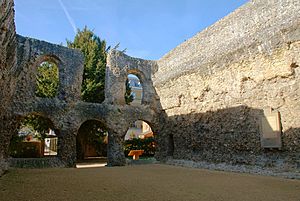
Like other rulers of his time, Henry gave money to the Church. He supported several religious groups. But writers of the time did not see him as an unusually religious king. His personal beliefs might have grown stronger over his life. Henry had always been interested in religion. But in his later years, he might have become more concerned about spiritual matters. If so, big changes in his thinking seem to have happened after 1120. That was when his son William Adelin died. And again in 1129, when his daughter's marriage was in trouble.
Henry supported religious reform. He gave a lot to reform groups within the Church. He was a strong supporter of the Cluniac order. This was probably for intellectual reasons. He gave money to the abbey at Cluny itself. After 1120, he gave generously to Reading Abbey, a Cluniac place. Construction on Reading began in 1121. Henry gave it rich lands and many special rights. It became a symbol of his family line. He also worked to change groups of clerks into Augustinian canons. He founded leper hospitals. He expanded nunneries. He also supported the Savigniacs and Tironensians. He loved collecting holy objects. He sent people to Constantinople in 1118 to collect Byzantine items. Some of these were given to Reading Abbey.
Later Reign (1107–1135)
Challenges from France and Wales
Normandy faced more threats from France, Anjou, and Flanders after 1108. King Louis VI became French king in 1108. He started to make the central royal power stronger. Louis demanded Henry show loyalty to him. He also wanted two disputed castles on the Normandy border to be controlled by neutral people. Henry refused. Louis responded by gathering an army. After some arguments, the two kings agreed to a truce. They left without fighting. The main problems were not solved. Fulk V took power in Anjou in 1109. He started to rebuild Angevin power. He inherited the county of Maine. But he refused to recognize Henry as his feudal lord. Instead, he allied with Louis. Robert II of Flanders also joined the alliance briefly. He died in 1111.
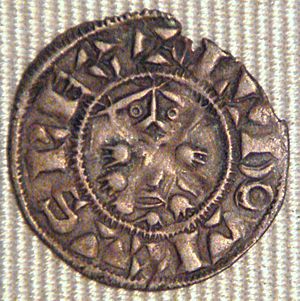
In 1108, Henry promised his six-year-old daughter, Matilda, to Henry V. He was the future Holy Roman Emperor. For King Henry, this was a very important match. For Henry V, it was a chance to get money. He received a dowry of £6,666 from England and Normandy. Raising this money was hard. It required a special tax in England. Matilda was crowned German queen in 1110.
Henry responded to the French and Angevin threat. He expanded his network of supporters beyond Normandy's borders. Some Norman nobles who were not trusted were arrested or lost their lands. Henry used these lands to gain allies in neighboring areas, especially Maine. Around 1110, Henry tried to arrest the young William Clito. But William's guardians moved him to safety in Flanders. Around this time, Henry probably started calling himself the Duke of Normandy. Robert of Bellême turned against Henry again. When he appeared at Henry's court in 1112 as a French ambassador, he was arrested and imprisoned.
Rebellions broke out in France and Anjou between 1111 and 1113. Henry went to Normandy to support his nephew, Count Theobald II, Count of Champagne. Theobald had sided against Louis in the uprising. To isolate Louis, Henry promised his young son, William Adelin, to Fulk's daughter Matilda. He also married his daughter Matilda to Duke Conan III of Brittany. This created alliances with Anjou and Brittany. Louis backed down. In March 1113, he met with Henry near Gisors. They agreed to a peace deal. Henry got the disputed fortresses. His rule over Maine, Bellême, and Brittany was confirmed.
Meanwhile, the situation in Wales was getting worse. Henry had fought a campaign in South Wales in 1108. He expanded royal power there. He settled Flemings around Pembroke. By 1114, some Norman lords were under attack. In Mid-Wales, Owain ap Cadwgan blinded a political hostage. In North Wales, Gruffudd ap Cynan threatened the Earl of Chester. Henry sent three armies into Wales that year. Owain and Gruffudd asked for peace. Henry accepted a political compromise. He strengthened the Welsh borders with his own appointees.
Rebellion and War (1115–1120)
Henry was worried about who would rule after him. He tried to convince Louis VI to accept his son, William Adelin, as the future Duke of Normandy. In exchange, William would promise loyalty to Louis. Henry went to Normandy in 1115. He gathered the Norman nobles to swear loyalty to William. He almost made a deal with Louis. It would confirm William's right to the Duchy for a large sum of money. But Louis, supported by Baldwin of Flanders, instead declared that William Clito was the rightful heir to the Duchy.
War broke out after Henry returned to Normandy with an army. He supported Theobald of Blois, who was under attack from Louis. Henry and Louis raided each other's towns along the border. A wider conflict started in 1116. Henry was forced to defend himself. French, Flemish, and Angevin forces began to raid the Norman countryside. Amaury III of Montfort and many other nobles rebelled against Henry. There was also a plot to kill him from within his own household. Henry's wife, Matilda, died in early 1118. But the situation in Normandy was so urgent that Henry could not return to England for her funeral.
Henry fought back against the rebel nobles. He also strengthened his alliance with Theobald. Baldwin of Flanders was wounded in battle and died in September 1118. This eased the pressure on Normandy from the north-east. Henry tried to crush a revolt in Alençon. But he was defeated by Fulk and the Angevin army. Henry had to retreat from Alençon. His position became very bad. His resources were stretched thin, and more nobles abandoned him. In early 1119, Eustace of Breteuil and Henry's daughter, Juliana, threatened to join the rebellion. Hostages were exchanged to avoid conflict. But relations broke down. Henry attacked and took the town of Breteuil, Eure. This was despite Juliana trying to kill her father with a crossbow. After this, Henry took almost all their lands in Normandy.
Henry's situation improved in May 1119. He convinced Fulk to switch sides. He finally agreed to marry William Adelin to Fulk's daughter, Matilda. He also paid Fulk a large sum of money. Fulk left for the Levant. He left the County of Maine in Henry's care. The King was then free to focus on defeating his remaining enemies. During the summer, Henry advanced into Normandy. He met Louis's army, leading to the Battle of Brémule. Henry seemed to have used scouts. He then arranged his troops into several lines of dismounted knights. The French knights stayed on horseback. They quickly charged the Anglo-Norman positions. They broke through the first line but got stuck in Henry's second line. Surrounded, the French army began to fall apart. In the close fighting, Henry was hit by a sword. But his armor protected him. Louis and William Clito escaped the battle. Henry returned to Rouen in triumph.
The war slowly ended after this battle. Louis took the dispute over Normandy to Pope Callixtus II's council in Reims that October. Henry faced French complaints about how he took and managed Normandy. Henry's case was defended by Geoffrey, the Archbishop of Rouen. But the pro-French people at the council shouted him down. Callixtus did not support Louis. He simply advised the two rulers to seek peace. Amaury de Montfort made peace with Henry. But Henry and William Clito could not find a good compromise. In June 1120, Henry and Louis formally made peace. The terms were good for the King of England. William Adelin promised loyalty to Louis. In return, Louis confirmed William's rights to the Duchy.
Succession Crisis (1120–1124)

Henry's plans for who would rule after him were ruined. This happened when the White Ship sank on 25 November 1120. Henry had left the port of Barfleur for England in the early evening. William Adelin and many younger members of the court were to follow that night. They were on a separate ship, the White Ship. Just outside the harbor, the ship hit a hidden rock. The ship sank. As many as 300 people died. Only one person survived. Henry's court was too scared to tell him about William's death at first. When he was finally told, he was overcome with sadness.
The disaster left Henry with no legitimate son. His nephews were now the closest male heirs. Henry announced he would marry a new wife, Adeliza of Louvain. This opened the chance of having another royal son. They married at Windsor Castle in January 1121. Henry seems to have chosen her because she was attractive and from an important noble family. Adeliza seemed to like Henry. She traveled with him, probably to increase their chances of having a child. The White Ship disaster also started new fighting in Wales. The drowning of Richard, Earl of Chester, led to a rebellion. Henry went to North Wales that summer with an army. He was hit by a Welsh arrow. But the campaign made royal power strong again across the region.
Henry's alliance with Anjou started to break apart. This alliance was based on his son William marrying Fulk's daughter Matilda. Fulk returned from the Middle East. He demanded that Henry return Matilda and her dowry. The dowry included lands and castles in Maine. Matilda left for Anjou. But Henry argued that the dowry had belonged to him first. So, he refused to give the lands back to Anjou. Fulk married his daughter Sibylla to William Clito. He gave them Maine. Again, fighting broke out. Amaury de Montfort allied with Fulk. He led a revolt along the Norman-Anjou border in 1123. Several other Norman nobles joined Amaury. This included Waleran de Beaumont, a son of Henry's old ally.
Henry sent Robert of Gloucester and Ranulf le Meschin to Normandy. Then he went himself in late 1123. He started besieging the rebel castles. He spent the winter in Normandy. In the spring of 1124, fighting began again. In the battle of Bourgthéroulde, Odo Borleng led the King's army. He learned that the rebels were leaving their base. This allowed him to ambush them in the forest. Waleran charged the royal forces. But his knights were cut down by Odo's archers. The rebels were quickly defeated. Waleran was captured, but Amaury escaped. Henry crushed the rest of the rebellion. He blinded some of the rebel leaders. At the time, this was seen as more merciful than execution. He also got back the last rebel castles. He paid Pope Callixtus a lot of money. In return, the Pope canceled the marriage of William Clito and Sibylla. This was because they were too closely related.
Planning for the Future (1125–1134)
Henry and Adeliza did not have any children. This led to talk about why. The future of the royal family seemed at risk. Henry might have started looking at his nephews for a possible heir. He might have thought about Stephen of Blois. Perhaps to prepare for this, he arranged a good marriage for Stephen. Stephen married a rich heiress, Matilda. Theobald of Blois, Henry's close ally, might also have felt he was favored by Henry. William Clito, King Louis's choice, was still against Henry. So, he was not suitable. Henry might also have considered his own son, Robert of Gloucester. But English tradition would not have favored an illegitimate son.
Henry's plans changed when Empress Matilda's husband, Emperor Henry, died in 1125. The King called his daughter back to England the next year. He declared that if he died without a son, she would be his rightful successor. The Anglo-Norman nobles gathered at Westminster in Christmas 1126. They swore to recognize Matilda and any future legitimate children she might have. Naming a woman as a possible heir was unusual. Opposition to Matilda continued in the English court. Louis was strongly against her.
New fighting broke out in 1127. The childless Charles I, Count of Flanders, was murdered. This caused a crisis over who would rule Flanders. With King Louis's support, William Clito was chosen as the new ruler of Flanders. This threatened Normandy. Henry started to pay for a war in Flanders. He supported William's rivals there. To break the French alliance with William, Henry attacked France in 1128. This forced Louis to stop helping William. William died unexpectedly in July. This removed the last major challenger to Henry's rule. It also stopped the war in Flanders. Without William, the rebel nobles in Normandy had no leader. A new peace was made with France. Henry was finally able to release the remaining prisoners from the 1123 revolt. This included Waleran of Meulan, who was welcomed back to the royal court.
Meanwhile, Henry rebuilt his alliance with Fulk of Anjou. This time, he married Matilda to Fulk's oldest son, Geoffrey. They were promised to each other in 1127 and married the next year. It is not known if Henry meant for Geoffrey to have any future claim on England or Normandy. He probably kept his son-in-law's status unclear on purpose. Matilda was given several castles in Normandy as part of her dowry. But it was not said when they would actually get them. Fulk left Anjou for Jerusalem in 1129. He declared Geoffrey the Count of Anjou and Maine. The marriage was difficult. The couple did not like each other much. The disputed castles caused problems. Matilda returned to Normandy later that year. Henry seemed to blame Geoffrey for the separation. But in 1131, the couple made up. To Henry's great joy, Matilda then had two sons: Henry in 1133 and Geoffrey in 1134.
Henry's Death and What Happened Next
Henry's Final Days
Relations between Henry, Matilda, and Geoffrey became more difficult in the King's last years. Matilda and Geoffrey suspected they did not have real support in England. In 1135, they urged Henry to give the royal castles in Normandy to Matilda while he was still alive. They insisted that the Norman nobles swear loyalty to her right away. This would give the couple a stronger position after Henry's death. Henry angrily refused. He was probably worried that Geoffrey would try to seize power in Normandy. A new rebellion broke out among the nobles in southern Normandy. Geoffrey and Matilda supported these rebels.
Henry campaigned throughout the autumn. He strengthened the southern border. Then he traveled to Lyons-la-Forêt in November to hunt. He seemed healthy. There he became ill. According to one writer, he ate too many lampreys against his doctor's advice. His condition worsened over a week. When it seemed he would die, Henry confessed his sins. He called Archbishop Hugh of Amiens. Robert of Gloucester and other court members joined them. Following custom, preparations were made to settle Henry's debts. Orders to take away lands were canceled. The King died on 1 December 1135.
Despite Henry's efforts, who would be king was disputed. When news of the King's death spread, Geoffrey and Matilda were in Anjou. They were supporting the rebels against the royal army. This army included some of Matilda's supporters, like Robert of Gloucester. Many of these nobles had sworn to stay in Normandy until the late king was buried. This stopped them from returning to England. The Norman nobles discussed making Theobald of Blois king. Theobald's younger brother, Stephen of Blois, quickly crossed from Boulogne to England. He was with his soldiers. Hugh Bigod claimed that Henry, on his deathbed, had released the nobles from their oath to Matilda. With the help of his brother, Henry of Blois, Stephen took power in England. He was crowned king on 22 December. Matilda did not give up her claim to England and Normandy. She first appealed to the Pope against Stephen's coronation. Then she invaded England. This started a long civil war, known as the Anarchy, between 1135 and 1153.
How Historians See Henry I
Historians have used many sources to learn about Henry. These include accounts from writers of the time. There are also other documents, like early financial records. And there are surviving buildings and architecture. The three main writers who described Henry's life were William of Malmesbury, Orderic Vitalis, and Henry of Huntingdon. But each of them added their own opinions and used common story ideas. Other writers include Eadmer, Hugh the Chanter, and Abbot Suger. Also, the authors of the Welsh Brut. Not all royal documents from that time have survived. But there are several royal acts, charters, and letters. There are also some early financial records. Some of these have been found to be fakes. Others were changed later.
Later historians focused on stories about Henry's education. They gave him the title "Beauclerc," meaning "good scholar." This idea was repeated by historians in the Victorian and Edwardian times. But historian Charles David showed in 1929 that the extreme claims about Henry's education were not true. Modern histories of Henry started with Richard Southern's work in the early 1960s. After that, much research was done on different parts of his reign in England. Fewer studies focused on his rule in Normandy. Only two major modern biographies of Henry have been written. One was by C. Warren Hollister in 2001. The other was by Judith Green in 2006.
Historians' views of Henry's personality have changed over time. Earlier historians thought Henry was a cruel ruler. More recent historians see his way of giving justice more kindly. Especially when compared to the standards of his time. But even Judith Green has said that Henry was "in many respects highly unpleasant." And Alan Cooper noted that many writers of the time were probably too scared of the King to criticize him much. Historians have also debated if Henry's changes to government truly created a systematic, "administrative kingship." Or if his approach remained mostly traditional.
Henry's burial at Reading Abbey is marked by a local cross and a plaque. But Reading Abbey was slowly taken apart in the 16th century. The exact spot of his tomb is not certain. But the most likely place is now in a built-up area of central Reading. It is on the site of the former abbey choir. A plan to find his remains was announced in March 2015. This plan had support from English Heritage and Philippa Langley. She helped find and dig up Richard III.
Henry's Family and Children
Legitimate Children
Henry had two children with his first wife, Matilda of Scotland:
- Matilda, born in 1102.
- William Adelin, born in 1103.
He might have also had a son named Richard, who died young. Henry and his second wife, Adeliza of Louvain, had no children.
Illegitimate Children
Henry had many illegitimate children with different women.
Sons
- Robert, 1st Earl of Gloucester, born in the 1090s.
- Richard, raised by Robert Bloet, the Bishop of Lincoln.
- Reginald de Dunstanville, Earl of Cornwall, born in the 1110s or early 1120s.
- Robert FitzEdith.
- Gilbert FitzRoy.
- William de Tracy, possibly born in the 1090s.
- Henry FitzRoy.
- Fulk FitzRoy.
- William, full brother of Sybilla of Normandy.
Daughters
- Matilda FitzRoy, Countess of Perche.
- Matilda FitzRoy, Duchess of Brittany.
- Juliane, wife of Eustace of Breteuil.
- Mabel, wife of William Gouet.
- Constance, Viscountess of Beaumont-sur-Sarthe.
- Aline, wife of Matthew de Montmorency.
- Isabel, daughter of Isabel de Beaumont, Countess of Pembroke.
- Sybilla de Normandy, Queen of Scotland, probably born before 1100.
- Matilda Fitzroy, Abbess of Montivilliers.
- Gundrada de Dunstanville.
- Possibly Rohese, wife of Henry de la Pomerai.
- Emma, wife of Guy of Laval.
- Adeliza, the King's daughter.
- Elizabeth Fitzroy, the wife of Fergus of Galloway.
- Possibly Sibyl of Falaise.
Family Tree
: Bold borders indicate legitimate children of English monarchs
| Baldwin II King of Jerusalem |
Fulk IV Count of Anjou |
Bertrade of Montfort | Philip I King of France |
William the Conqueror King of England r. 1066–1087 |
Saint Margaret of Scotland | Malcolm III King of Scotland |
|||||||||||||||||||||||||||||||||||||||||||||||||||||||||||||||||||||||||||||||||||||||||||
| Melisende Queen of Jerusalem |
Fulk V King of Jerusalem |
Eremburga of Maine | Robert Curthose | William II King of England r. 1087–1100 |
Adela of Normandy | Henry I King of England r. 1100–1135 |
Matilda of Scotland | Duncan II King of Scotland |
Edgar King of Scotland |
Alexander I King of Scotland |
David I King of Scotland |
||||||||||||||||||||||||||||||||||||||||||||||||||||||||||||||||||||||||||||||||||||||
| Sibylla of Anjou | William Clito | Stephen King of England r. 1135–1154 |
Geoffrey Plantagenet Count of Anjou |
Empress Matilda | William Adelin | Matilda of Anjou | Henry of Scotland |
||||||||||||||||||||||||||||||||||||||||||||||||||||||||||||||||||||||||||||||||||||||||||
| Margaret I | Philip of Alsace Count of Flanders |
Louis VII King of France |
Eleanor of Aquitaine | Henry II King of England r. 1154–1189 |
Geoffrey Count of Nantes |
William FitzEmpress | Malcolm IV King of Scotland |
William the Lion King of Scotland |
|||||||||||||||||||||||||||||||||||||||||||||||||||||||||||||||||||||||||||||||||||||||||
| Baldwin I Latin Emperor |
Isabella of Hainault | Philip II King of France |
Henry the Young King | Matilda Duchess of Saxony |
Richard I King of England r. 1189–1199 |
Geoffrey II Duke of Brittany |
Eleanor | Alfonso VIII King of Castile |
Joan | William II King of Sicily |
John King of England r. 1199–1216 |
||||||||||||||||||||||||||||||||||||||||||||||||||||||||||||||||||||||||||||||||||||||
| Louis VIII King of France |
Otto IV Holy Roman Emperor |
Arthur I Duke of Brittany and Eleanor Fair Maid of Brittany |
Blanche of Castile Queen of France |
Henry III King of England r. 1216–1272 |
Richard of Cornwall King of the Romans |
Joan Queen of Scotland |
Alexander II King of Scotland |
||||||||||||||||||||||||||||||||||||||||||||||||||||||||||||||||||||||||||||||||||||||||||
Images for kids
-
Depiction of Bishop Odo (wielding club at centre) who imprisoned Henry from 1088–89. From the Bayeux Tapestry.
-
Mont Saint-Michel in Normandy, site of the 1091 siege
-
A 17th-century manuscript drawing of Henry's coronation.
-
Henry's first wife, Matilda of Scotland
-
The village of Tinchebray in Normandy in 2008; the site of the Battle of Tinchebray in 1106
-
The seal of Archbishop Anselm of Canterbury
-
The ruined chapter house of Reading Abbey in 2008
-
Denier coin of Henry's rival, Louis VI of France
-
Early 14th-century depiction of the sinking of the White Ship at Barfleur on 25 November 1120
-
Part of the Welsh Brut y Tywysogion, one of the chronicler sources for Henry's reign
See also
 In Spanish: Enrique I de Inglaterra para niños
In Spanish: Enrique I de Inglaterra para niños



